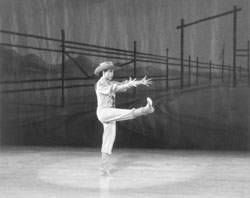Western Swing
Roping a Man: Karen Gabay dances across the Western range in San Jose Cleveland Ballet's "Rodeo."
San Jose Cleveland Ballet serves up a generous slice of Americana in Agnes De Mille's classic 'Rodeo'
By Janet Lynn Roseman
ONE OF THE reasons that the last weekend's opening night of Celebration of American Dance for San Jose Cleveland Ballet was so successful is that Artistic Director Dennis Nahat knows how to please. He fashioned a program that was more theatrical than most, and the crowd clearly enjoyed it.
Nahat's own Cannonade was the weakest of the three pieces on the program. Set to the gorgeous music of Bach's Piano Concerto No. 1 in D Minor, the choreography struggled to meet the artistry of its accompaniment. Instead of following the dance impulses of the music, the company members executed a variety of disparate movements that bore scant relation to the score.
The sense of isolation in the dancing--and lack of any kind of interconnectedness among the dancers--meant that the audience saw little more than groups of dancers, single dancers and lines of dancers performing continuous dance suites, with no apparent purpose.
The male company members proved that they were the stronger and more elegant dancers, moving with much more authentic spirit and vigor. Although the adagio was clearly favored by the audience, Ana Lobe and Mark Otloski need to feel more comfortable with each other's bodies. Their choreographic pairing was actually much stronger than the rest of the piece, but it could have been magnificent. Lobe appeared rather stiff, and the lifts seemed to strain Otloski.
The second piece, "In Studio D," which tells the story of the trials, joys, ambition and rejection in a dancer's life, has been constructed by Nahat as a series of miniballets accompanied by eight Broadway-worthy tunes sung by sassy vocalist Terry White, who has performed in Ain't Misbehavin' and Barnum and sung with Liza Minnelli.
"In Studio D" offers an intriguing mix of dance and vocals. We see the ballet barres of a dancer's studio, and the lovely and colorful costumes worn by the 10 dancers were visually very engaging. The dancers practice their techniques and perform short solos to which White's songs bring a theatrical dimension. It's filled with clichés (think A Chorus Line), but that didn't matter.
The only problem I had at first was deciding if I wanted to concentrate my attentions on the dancing or on the singing; it was difficult to do both. But Nahat's cameo appearance in his elegant tap-dancing solo, "Count Your Blessings," was a particular highlight. Nahat, a former principal dancer with the American Ballet Theatre, was smooth as silk. His spirit leaped off the stage, and his highly stylized tapping was absolutely gorgeous.
Saving the best for last, Agnes De Mille's Rodeo was wonderful. This famous, yet politically incorrect, Cinderella story set in the American West served as the precursor to the famous Broadway musical Oklahoma. De Mille personally set the work on the dancers in 1980 at age 75. Although she had suffered a stroke five years earlier and used a wheel chair to get around, she hadn't lost her pioneering spirit or her sense of humor.
Attempting to explain the ballet, according to Nahat (who danced in the piece in the '60s and '70s), she "told them things about how difficult it was to be a pioneer woman all alone, and got them to realize that what the West was about, for women, was trying to find a man."
De Mille's history lesson translates to: Tomboy Cowgirl tries to win the affection of the Head Wrangler with her rodeo skills, but he's more interested in a feminine woman. In the course of the 30-minute performance, she is transformed from Cowgirl to Cow Lady and, of course, gets the guy.
Karen Gabay was expressive as the Cowgirl and moved quite well in the piece, which is no small accomplishment. Both Raymond Rodriguez and Ramon Thielen (as the Roper and Head Wrangler) were also well cast. The dancers are required to folk dance, tap dance and modern dance in this piece, and for bodies trained in the rigid structure of classical ballet, learning to move easily from the center of the body (to mirror the movements of riding a horse) is very, very difficult.
In an effort to capture those movements, De Mille told her dancers in the original production to think "Crotch-sprung, saddle-sore, with rolled-over high heels and sweat-stained leather, ill at ease and alien to the ground, unhorsed centaurs." San Jose Cleveland's rendition didn't quite convince me that the dancers were saddle-sore, but their tribute to De Mille's slice of Americana was equal to the cheers it earned from the crowd.
[ Metro | Metroactive Central | Archives ]
This page was designed and created by the Boulevards team.

Christopher Gardner
From the October 17-23, 1996 issue of Metro
Copyright © 1996 Metro Publishing, Inc.
![[Metroactive Stage]](/stage/gifs/stage468.gif)